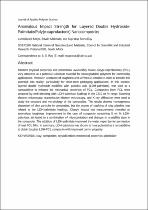 ResearchSpace
ResearchSpace
Anomalous impact strength for layered double hydroxide-palmitate/poly(e-caprolactone) nanocomposites
JavaScript is disabled for your browser. Some features of this site may not work without it.
- ResearchSpace
- →
- Research Publications/Outputs
- →
- Journal Articles
- →
- View Item
| dc.contributor.author |
Moyo, Lumbidzani

|
|
| dc.contributor.author |
Makhado, E

|
|
| dc.contributor.author |
Ray, Suprakas S

|
|
| dc.date.accessioned | 2014-12-15T07:32:29Z | |
| dc.date.available | 2014-12-15T07:32:29Z | |
| dc.date.issued | 2014-11 | |
| dc.identifier.citation | Moyo, L., Makhado, E. and Ray, S.S. 2014. Anomalous impact strength for layered double hydroxide-palmitate/poly(e-caprolactone) nanocomposites. Journal of Applied Polymer Science, vol.131(22) | en_US |
| dc.identifier.issn | 0021-8995 | |
| dc.identifier.uri | http://onlinelibrary.wiley.com/doi/10.1002/app.41109/pdf | |
| dc.identifier.uri | http://hdl.handle.net/10204/7810 | |
| dc.description | Copyright: 2014 Wiley. Published in Journal of Applied Polymer Science, vol.131(22). Abstract only. | en_US |
| dc.description.abstract | Inherent physical properties and commercial availability makes poly(e-caprolactone) (PCL) very attractive as a potential substitute material for nondegradable polymers for commodity applications. However, a balance of toughness and stiffness is needed in order to transfer this potential into reality, particularly for short-term packaging applications. In this context, layered double hydroxide modified with palmitic acid (LDH-palmitate), was used as a nanoadditive to enhance the mechanical properties of PCL. Composites from PCL were prepared by melt-blending with LDH-palmitate loadings in the 1210 wt % range. Scanning electron microscopy, transmission electron microscopy, and X-ray diffraction were used to study the structure and morphology of the composites. The results showed homogeneous dispersion of clay particles in composites, but the degree of stacking of clay platelets was related to the LDH-palmitate loadings. Charpy impact test measurements revealed an anomalous toughness improvement in the case of composite containing 5 wt % LDH-palmitate, attributed to a combination of microcavitation and changes in crystallite sizes in the composite. The addition of LDH-palmitate improved the water vapor barrier permeation of neat PCL film. In summary, LDH-palmitate was shown to have potential as a nanoadditive to obtain tougher LDH-PCL composite with improved barrier property. | en_US |
| dc.language.iso | en | en_US |
| dc.publisher | Wiley | en_US |
| dc.relation.ispartofseries | Workflow;13759 | |
| dc.subject | Clay | en_US |
| dc.subject | Composites | en_US |
| dc.subject | Crystallization | en_US |
| dc.subject | Mechanical properties | en_US |
| dc.subject | Plasticizer | en_US |
| dc.title | Anomalous impact strength for layered double hydroxide-palmitate/poly(e-caprolactone) nanocomposites | en_US |
| dc.type | Article | en_US |
| dc.identifier.apacitation | Moyo, L., Makhado, E., & Ray, S. S. (2014). Anomalous impact strength for layered double hydroxide-palmitate/poly(e-caprolactone) nanocomposites. http://hdl.handle.net/10204/7810 | en_ZA |
| dc.identifier.chicagocitation | Moyo, Lumbidzani, E Makhado, and Suprakas S Ray "Anomalous impact strength for layered double hydroxide-palmitate/poly(e-caprolactone) nanocomposites." (2014) http://hdl.handle.net/10204/7810 | en_ZA |
| dc.identifier.vancouvercitation | Moyo L, Makhado E, Ray SS. Anomalous impact strength for layered double hydroxide-palmitate/poly(e-caprolactone) nanocomposites. 2014; http://hdl.handle.net/10204/7810. | en_ZA |
| dc.identifier.ris | TY - Article AU - Moyo, Lumbidzani AU - Makhado, E AU - Ray, Suprakas S AB - Inherent physical properties and commercial availability makes poly(e-caprolactone) (PCL) very attractive as a potential substitute material for nondegradable polymers for commodity applications. However, a balance of toughness and stiffness is needed in order to transfer this potential into reality, particularly for short-term packaging applications. In this context, layered double hydroxide modified with palmitic acid (LDH-palmitate), was used as a nanoadditive to enhance the mechanical properties of PCL. Composites from PCL were prepared by melt-blending with LDH-palmitate loadings in the 1210 wt % range. Scanning electron microscopy, transmission electron microscopy, and X-ray diffraction were used to study the structure and morphology of the composites. The results showed homogeneous dispersion of clay particles in composites, but the degree of stacking of clay platelets was related to the LDH-palmitate loadings. Charpy impact test measurements revealed an anomalous toughness improvement in the case of composite containing 5 wt % LDH-palmitate, attributed to a combination of microcavitation and changes in crystallite sizes in the composite. The addition of LDH-palmitate improved the water vapor barrier permeation of neat PCL film. In summary, LDH-palmitate was shown to have potential as a nanoadditive to obtain tougher LDH-PCL composite with improved barrier property. DA - 2014-11 DB - ResearchSpace DP - CSIR KW - Clay KW - Composites KW - Crystallization KW - Mechanical properties KW - Plasticizer LK - https://researchspace.csir.co.za PY - 2014 SM - 0021-8995 T1 - Anomalous impact strength for layered double hydroxide-palmitate/poly(e-caprolactone) nanocomposites TI - Anomalous impact strength for layered double hydroxide-palmitate/poly(e-caprolactone) nanocomposites UR - http://hdl.handle.net/10204/7810 ER - | en_ZA |





